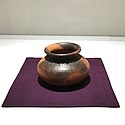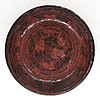Shimamono
Shimamono(Đảo vật,"island objects" )is a generic term forJapanese tea utensilsproduced outside Japan, Korea and China, mainly fromSoutheast Asia.
History
[edit]Items from Korea, calledkōraimono(Cao Ly vật),and from China, calledkaramono(Đường vật),are not consideredshimamono.
They were imported with ships on trade routes and started becoming popular in the 15th and 16th centuries. The term therefore can be taken literally to mean "island objects". By the time of the rule of theShōgunTokugawa Yoshimune,imitationshimamonowere also produced in Japan. However, at this point they were called "striped objects", but the pronunciation remained the same.[1]As such they can be counted as part ofJapanese pottery and porcelain.
The treatiseTōkikōdescribes the Japanese pottery trade with Asia and gives detailed descriptions.[2]
Types
[edit]| Name | Kanji | Origins | Notes | Example image |
|---|---|---|---|---|
| Rusun ware | Lữ Tống thiêu | Luzon | Pottery items. The merchantRuson Sukezaemon( Lữ Tống trợ tả vệ môn ) was particularly connected to the trade inRusunware during the rule ofToyotomi Hideyoshiin the 16th century.[3][4][5]Grouped together withMishima ware | [6] |
| Annan ware | An Nam thiêu | Annam | Oftenblue and white potterythat was later produced in Japan as well. These were originally used as rice bowls but repurposed in Japan for tea. They feature simplified floral motifs as decoration, and their mark is an unusual high foot. A variant is in red and green colours, known asBeni Annan( hồng An Nam ). A rarechawanfrom the 16th century is kept at theTokugawa Museumin Nagoya and inscribed as an Important Art Object.[7] | 
|
| Nanban ware | Nam Man thiêu | Southeast Asia | Items from southeast Asia without exact provenience |  [8][9][10] [8][9][10]
|
| Amakawa | アマカワ | Macau | White clay and grayish glaze. Grouped together withMishima ware | |
| Mōru/Mo-ru | モウル / モール | Moluccas | [11] | |
| Tō Indu/Tenji | Đông インドゥ | eastern India | ||
| Kōchi ware | Giao ngón chân thiêu | southern China | Developed fromCochin warefrom southern China. Generally in colours yellow, green and blue. | 
|
| Nekoro | ネコロ | Nicobar Islands | ||
| Taiwan | Đài Loan | Taiwan | Grouped together withMishima ware | |
| Hannera | ハンネラ | Southeast Asia | A type of simple unglazed ware, often reddish or orange in colour |  [12] [12]
|
| Kinma | Củ 醤 | SiamorBurma | A style oflacquerware with finely inlaid patterns |  [13] [13]
|
| Koma | Độc lặc | Siam | Lacquerware, called "spinning top"(koma) because the colours are painted in concentrical rotating patterns |  [14] [14]
|
| Sahari | Sa trương | Southeast Asia | Is a general term for metalware, specifically an alloy mainly made of copper containing a small amount of silver and lead, mainly adding tin from southeast Asia origin. It appeared from the end of the Muromachi perdiod until the Momoyama period. The products were initially not made as tea utensils, but found entry through tea masters.[15] | [16][17] |
See also
[edit]References
[edit]- ^"Chinese Pottery in the Philippines".Field Museum of NaturalHistory. 1912.
- ^"Chinese Pottery in the Philippines".Field Museum of NaturalHistory. 1912.
- ^Manansala, Paul Kekai (October 2006).Quests of the Dragon and Bird Clan.Lulu.ISBN9781430308997.
- ^sambali.blogspot /2006/09/luzon-jars-glossary.html
- ^http://photos1.blogger /blogger/6514/3214/1600/Kyoto%20002.jpg[bare URL image file]
- ^"Nâu men gốm bốn nhĩ hồ ( Lữ Tống hồ )".
- ^"【 quan trọng mỹ thuật phẩm 】 hồng An Nam thảo hoa văn bát trà".
- ^"Thường trực triển lãm: Điền điền quang chi Nam Man thiêu đính hồ".
- ^"Thạch xuyên long nhi さん の Nam Man thiêu đính め chén".
- ^"Nam Man thiêu đính hoa khí Nanbanyakishime vase- うつわ tường thấy web shop".utsuwa-shoken.shop-pro.jp.Archived fromthe originalon 2018-01-16.
- ^"Buôn bán buôn bán 【 trà đạo cụ 】 kiến thủy モオル quy giáp *モール* mao dệt *モウル* trà đạo đạo cụ".seiyudo.ocnk.net.Archived fromthe originalon 2015-12-07.
- ^"ハンネラ kiến thủy - Miho Museum".
- ^"Kimma - Lacquerwares of Thailand".
- ^"Vintage Japanese Tea Ceremony Chu-Natsume | Kagawa Lacquer Tea Caddy | 1940s | Mingei Arts".mingeiarts.Archived fromthe originalon 2016-08-03.
- ^"Sa trương bổng の trước thủy chỉ | công ích tài đoàn pháp nhân năm đảo phòng tranh".
- ^"C0077196 sa trương túi hình kiến thủy - Đông Kinh quốc lập viện bảo tàng bức họa kiểm tác".
- ^"02098_001".Archived fromthe originalon 2015-10-06.Retrieved2018-01-15.
Literature
[edit]![]() Media related toShimamonoat Wikimedia Commons
Media related toShimamonoat Wikimedia Commons


